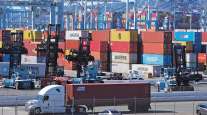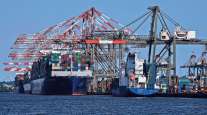Senior Reporter
Nation’s Ports Set Records, but Concerns Heighten Over Tariffs

Ports across the United States are reporting record volumes, but transportation officials are raising concern that economic tariffs being imposed against other countries by the Trump administration — and retaliatory efforts those nations are enacting in response — could affect the longer-term global trade outlook.
“Retailers have been forecasting a good peak season for containerized imports, so June’s numbers weren’t surprising,” Port of Oakland Maritime Director John Driscoll said in a statement. “But there’s uncertainty over the international trade picture, so we’re taking a wait-and-see attitude.”
For June, at least, things looked good at Driscoll’s facility; the Port of Oakland handled 87,207 20-foot equivalent units, or TEUs, during the month, an 8.7% year-over-year increase and an all-time monthly record.

Driscoll
The news was similar across other ports. The Northwest Seaport Alliance, which operates the ports of Seattle and Tacoma, said May imports reached 131,067 TEUs, up from 115,960 a year go and the highest level seen since 2010.
The Port of Savannah, Ga., reported its busiest May on record and second-busiest month in its history by moving 361,029 TEUs, a jump of 3.1% over the 350,105 TEUs handled in May 2017. And Port Houston shattered its all-time container volume record during the month, moving 245,996 TEUs compared with 213,893 a year ago.
The Port of Baltimore had its best-ever first quarter in 2018 as cargo volume rose 8% to 2.765 million tons from 2,560,065 tons last year. The port moved 156,991 during the period, compared with 126,367 during the first quarter of 2017.
The Port of New York and New Jersey reported year-to-date volume through May of 2,825,103 TEUs, 6.8% higher than the year-ago number of 2,645,069.
“You are seeing it on all of the coasts, East, West, Gulf and overall, a number of the Great Lakes ports are doing well, too,” Kurt Nagle, president of the American Association of Port Authorities, told Transport Topics. “Trade in general is up, so it’s a far more broad barometer, opposed to Port X gaining at the expense of Port Y.”

Port of Seattle. (Mike Kane/Bloomberg News)
Container volume at the Port of Los Angeles for June declined 1.1%, to 723,141 TEUs from 731,032 in June 2017, but the figure was dragged down by empty container volume, which declined 9.7% to 192,613 TEUs from 213,232 a year ago. Imports rose 2.9% to 384,964 TEUs from 372,272, while exports improved 1.4% to 147,563 TEUs from 145,527.
While Executive Director Gene Seroka noted that the port ended fiscal 2018 on June 30 with total volume of more than 9.1 million TEUs for the second straight year, the result marked a less than 1% dip from the prior year, during which the port set a record for container volume with 9.2 million TEUs. Seroka also noted that the potential impact from tariffs “provides a level of uncertainty and potentially softened trade flows through our port during the second half of 2018.”
During July 18 testimony before the Senate Finance Committee’s Subcommittee on International Trade, Customs and Global Competitiveness, the AAPA’s Nagle expressed concern from within the association’s membership that tariffs could, when coupled with retaliatory actions by America’s trading partners, “adversely affect employment at ports and throughout the goods-movement supply chain,” and stressed that leaders must keep an eye on the big picture.

Nagle
“We think that it’s very important that, before any specific sanctions are put in place, that they should look broader than just a particular industry or commodity. Also look at the transportation network, including ports, truckers, rail or what the impact will be to jobs in those areas,” Nagle said.
During his TT interview, Nagle pointed to recent AAPA research that shows President Donald Trump’s newly imposed trade sanctions will impact 9% of the total volume of products imported and exported to the United States. Trade with China accounts for 16% of items moved in and out of California ports, 13% in Georgia and 12% in Washington state, he said.
One trucking official said while some have suggested fear of tariffs is helping to lift recent port volume, he believes the results are more business-driven.
“It has been a pretty consistent climb over the last few years in terms of volumes,” Alex Cherin, executive director of the California Trucking Association’s Intermodal Carriers Conference, told Transport Topics. “There has been a little bit of rumbling [that] the tariff issue will impact some of the volume coming into the West Coast because that is predominantly Chinese-originated cargo, but we haven’t seen that just yet. By all other indications it’s full steam ahead.”




